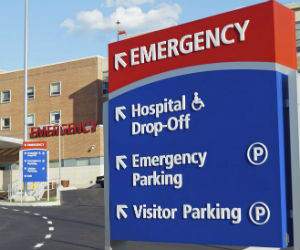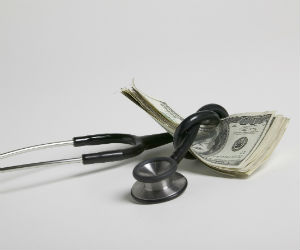Robust security systems are a must for any health care facility, not just for patients’ safety but also for staff and expensive medical equipment. This has become all the more significant of late, as the hospitals look to expand their reach and provide round-the-clock service.
Robust security systems are a must for any health care facility, not just for patients’ safety but also for staff and expensive medical equipment. This has become all the more significant of late, as hospitals look to expand their reach and provide round-the-clock service.
“The overall demand hasn’t been any higher than it’s been the past two years in the United States,” said Greg Love, VP of Sales at AMAG Technology, adding that from a security standpoint, he has seen an increase in level 1 trauma centers located in inner city areas.
Patients in such trauma centers are often gunshot victims, and better security systems are necessary to protect those victims and hospital staff from alleged perpetrators who may want to cause more harm.
Common threats to counter in health care
Identifying the common threats and concerns is the first step to providing the best solution. According to Katharina Geutebrück, CEO of Geutebrück, there are quite a few of them in hospitals.
 Common threats in this hospitals range
Common threats in this hospitals range
from vandalism to kidnapping.
“There is a long list of threats — theft, vandalism, property damage, sabotage, kidnapping,” said Geutebrück. “But also the internal organization is at risk: there are drivers like understaffing as well as ill-treatment of patients and legal claims.”
Sheila Stromberg, Director of Healthcare End-User Strategies at HID Global feels that threats can be broadly divided into those concerning the safety of staff, patients, and visitors, and those to the security of patient information and other data. The most important challenge could be general nature of hospital buildings and their operation.
“Physical security threats can be difficult to combat because of the modern hospital’s typically large campus size and often geographically dispersed nature of many facilities,” Stromberg said. “It’s also difficult to support secure access from affiliated doctors who may work with many different institutions, requiring them to carry multiple badges for all the locations they visit.”
Managing visitors to the hospital
Even if precautions are taken to counter issues such as unauthorized access, managing visitors is a sensitive issue.
 Solutions like video analytics assist in
Solutions like video analytics assist in
operations such as parking management.
“Visitors are a challenge — some may pose a threat, all must be protected, and the challenge is more difficult during ‘after hours’ periods and in critical areas such as labor and delivery floors and pediatric wards,” said Stromberg. “On the information security side, threats to patient privacy take many forms, and safeguards must extend to electronically prescribed medications, as well.”
What’s the right security solution in this vertical?
In Geutebrück’s opinion, video security offers the possibility to monitor automatically or manually what needs to be seen for preventive and repressive measures. But this could only solve part of the problem. Stromberg believes that threats can mainly be countered by an access control system that provides a sense of safety and the confidence of knowing that only authorized personnel are on the premises.
“The latest solutions support many access control applications on the same smart card, from access control for the parking lot, main door, emergency room, and pharmacy to visual ID verification, time-and-attendance, payroll transactions, and cafeteria purchases,” said Stromberg. “They also enable the integration of visitor management systems to optimize badging efficiency as part of a complete solution that supports real-time patient feeds and Health Level Seven International (HL7) integration.”
Innovations in access control technology
Of late, access control systems have also been developed to deliver the ability to “tap” in and out of computer applications, reducing the need for complex passwords in healthcare environments where staff often needs to make 20 or more logins each day to access the facility’s enterprise data and services.
 Developements in access control
Developements in access control
technology are helping the health care industry.
With new systems, a user simply taps his or her ID card to a laptop, tablet, phone or other NFC-enabled device to access network resources, cloud apps and web-based services. There is also the added benefit of being able to use the same card that opens doors to access data and cloud-based applications.
In short, tap authentication improves user convenience for opening doors and accessing data, while helping hospitals align information security and safety, meet compliance needs, and ensuring patients’ privacy.
Providing affordable solutions
It’s not just about the availability of solutions, but their affordability that matters in the health care industry. Ann Timme, Vertical Marketing Manager for Healthcare at Allegion addressed this issue as she explained how hospitals can boost safety without incurring huge expenses.
 Hospitals are concerned about the
Hospitals are concerned about the
affordability of security solutions.
“One way to economically increase security or add security to more openings is to use wireless electronic locks, which are easier and less expensive to install than traditional wired devices, and provide more control and visibility to the security at these openings,” Timme said. “And now there are several options that meet the needs of any opening or healthcare organization.”
Another way to consider the economic aspect could be looking at the operational improvements that these solutions offer beyond security itself. Geutebrück noted that video surveillance systems are not just for security, but also help to optimize the health care process.
“Features like live transmission of medical procedures or recordings offer additional interesting medical applications for example for training purposes or to consult specialists who are not on site,” Geutebrück said.
Different solutions for different medical departments
A crucial point about providing security solutions in health care facilities is understanding the different kinds of activities that go on in different departments of a hospital and the their subsequent security requirements. Love stressed this point as he provided points such as hospitals in urban areas requiring special attention in the trauma/emergency care areas, among other measures.
“Hospitals that can afford it should install infant abduction systems that are integrated with their access control system,” Love said. “Infant abduction systems lock all doors and elevators in the event of a security breach. Research hospitals require strict access control to protect labs and the highly sensitive work going on within them.”
 Different medical divisions have different
Different medical divisions have different
security requirements.
Timme talked further on the importance of giving special focus to the emergency department.
“Active assailant situations, domestic or gang incidents are often brought into the emergency department, and patient/family violence against staff members are common,” Timme said. “While the hope is to stop violence before it happens or escalates, these incidents may be contained and controlled with the proper security lockdown procedures and processes.”
By using real-time access control solutions such as an access control system with credential readers, wireless electronic locks, panic buttons, and other components, it’s possible to restrict access to other departments of the facility and keep patients and staff safe.
Geutebrück too agreed that different divisions require different solutions, explaining the precise process that can protect a health care facility.
“Imagine a high-security area of a forensic facility where mentally ill offenders with immense criminal potential are treated,” Geutebrück said. “If one of these persons escapes, the consequences can be fatal. An effective early warning protection system is needed, like our professional thermal imaging cameras combined with our intelligent video analysis system.”
Such a system would detect any unusual movement around buildings or windows, in total darkness, rain or snow and without the need for additional lighting. Analysis algorithms can detect the size, speed, and direction of movement of an object and alert the monitoring control center in real time. Video motion detection can also be applied indoors, ideally with IR-LED equipped cameras which need no additional lighting at night.
Towards more secure health care systems
The global demand for health care security solutions is expected to grow further. Once viewed as a necessary evil, security solutions are a must for hospitals today. According to Stromberg, unlike several other verticals, the health care industry is actively investing in security infrastructure for both continuous renovations of existing buildings and to protect new constructions.
Several steps from governments are also influencing the factors. For instance, a major demand driver in the U.S. is the changing landscape under the Affordable Care Act and a move to value-based rather than fee-for-service health care. For solution providers and systems integrators, this means more room to consider closer integration with the hospital processes.